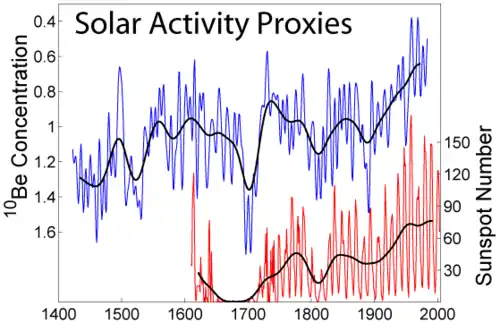Beryllium-10
| General | |
|---|---|
| Symbol | 10Be |
| Names | beryllium-10 |
| Protons (Z) | 4 |
| Neutrons (N) | 6 |
| Nuclide data | |
| Natural abundance | trace |
| Half-life (t1/2) | 1.387×106 years[1] |
| Spin | 0+ |
| Binding energy | 64976.3±0.08 keV |
| Decay products | 10B |
| Decay modes | |
| Decay mode | Decay energy (MeV) |
| β− | 0.5560[2] |
| Isotopes of beryllium Complete table of nuclides | |
Beryllium-10 (10Be) is a radioactive isotope of beryllium. It is formed in the Earth's atmosphere mainly by cosmic ray spallation of nitrogen and oxygen.[3][4][5] Beryllium-10 has a half-life of 1.387 million years and decays by beta decay to stable boron-10 with a maximum energy of 556.0 keV. It decays through the reaction 10Be→10B + e−. Light elements in the atmosphere react with high energy galactic cosmic ray particles; at such energies nucleons are knocked out almost at random, and any nucleus lighter than the original can remain.

Because beryllium tends to exist in solutions below about pH 5.5 (and rainwater above many industrialized areas can have a pH less than 5), it will dissolve and be transported to the Earth's surface via rainwater. As the precipitation quickly becomes more alkaline, beryllium drops out of solution. Cosmogenic 10Be thereby accumulates at the soil surface, where its relatively long half-life does not limit its residence time there.
10Be and its daughter product have been used to examine soil erosion, soil formation from regolith, the development of lateritic soils and the age of ice cores.[6] It is also formed in nuclear explosions by a reaction of fast neutrons with 13C in the carbon dioxide in air, and is one of the historical indicators of past activity at nuclear test sites. 10Be decay is a significant isotope used as a proxy data measure for cosmogenic nuclides to characterize solar and extra-solar attributes of the past from terrestrial samples.[7]
The rate of production of beryllium-10 depends on the activity of the sun. When solar activity is low (low numbers of sunspots and low solar wind), the barrier against cosmic rays that exists beyond the termination shock is weakened (see Cosmic ray#Cosmic-ray flux). This means more beryllium-10 is produced, and it can be detected millennia later. Beryllium-10 can thus serve as a marker of Miyake events, such as the 774–775 carbon-14 spike. There can be an effect on climate[8] (see Homeric Minimum). While other cosmogenic isotopes experience similar cycles, the high rate of production, long half-life, and relative immobility in the environment make this most suitable for this purpose.
See also
References
- ^ Kondev, F. G.; Wang, M.; Huang, W. J.; Naimi, S.; Audi, G. (2021). "The NUBASE2020 evaluation of nuclear properties" (PDF). Chinese Physics C. 45 (3): 030001. doi:10.1088/1674-1137/abddae.
- ^ National Nuclear Data Center. "NuDat 3.0 database". Brookhaven National Laboratory.
- ^ G.A. Kovaltsov; I.G. Usoskin (2010). "A new 3D numerical model of cosmogenic nuclide 10Be production in the atmosphere". Earth Planet. Sci. Lett. 291 (1–4): 182–199. Bibcode:2010E&PSL.291..182K. doi:10.1016/j.epsl.2010.01.011.
- ^ J. Beer; K. McCracken; R. von Steiger (2012). Cosmogenic radionuclides: theory and applications in the terrestrial and space environments. Physics of Earth and Space Environments. Vol. 26. Physics of Earth and Space Environments, Springer, Berlin. doi:10.1007/978-3-642-14651-0. ISBN 978-3-642-14650-3. S2CID 55739885.
- ^ S.V. Poluianov; G.A. Kovaltsov; A.L. Mishev; I.G. Usoskin (2016). "Production of cosmogenic isotopes 7Be, 10Be, 14C, 22Na, and 36Cl in the atmosphere: Altitudinal profiles of yield functions". J. Geophys. Res. Atmos. 121 (13): 8125–8136. arXiv:1606.05899. Bibcode:2016JGRD..121.8125P. doi:10.1002/2016JD025034. S2CID 119301845.
- ^ Balco, Greg; Shuster, David L. (2009). "26Al-10Be–21Ne burial dating" (PDF). Earth and Planetary Science Letters. 286 (3–4): 570–575. Bibcode:2009E&PSL.286..570B. doi:10.1016/j.epsl.2009.07.025. Archived from the original (PDF) on 2015-09-23. Retrieved 2012-12-10.
- ^ Paleari, Chiara I.; F. Mekhaldi; F. Adolphi; M. Christl; C. Vockenhuber; P. Gautschi; J. Beer; N. Brehm; T. Erhardt; H.-A. Synal; L. Wacker; F. Wilhelms; R. Muscheler (2022). "Cosmogenic radionuclides reveal an extreme solar particle storm near a solar minimum 9125 years BP". Nat. Commun. 13 (214): 214. Bibcode:2022NatCo..13..214P. doi:10.1038/s41467-021-27891-4. PMC 8752676. PMID 35017519.
- ^ Philip Ball (Dec 19, 2001). "Flickering sun switched climate". Nature. doi:10.1038/news011220-9.